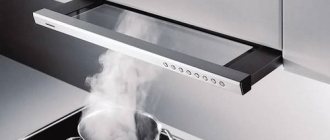HVAC equipment is an actively developing area of production. The need to install such equipment has become an integral element not only in the design and construction of office buildings or shopping centers - more and more often you can find projects of residential buildings in which a design solution is provided for the installation of an air conditioning system. Modern stationary air conditioners are also called split systems, due to their design feature - they consist of two parts: the indoor unit is in the room inside, and the outdoor unit is outside. Moreover, some models of split systems can not only cool the air in the room, but also heat it, that is, they work in winter-summer mode. How the air conditioner is heated, in which models this option is provided, and what parameters affect the choice - in the material below.
The validity of heating a room with an air conditioner
Often buyers have a question - what is the best way to heat the room, air conditioning or gas. To understand how profitable it will be to use the air conditioning system for this purpose, and to find the most economical heating method, it is necessary to compare several factors:
- device cost;
- operating conditions and restrictions - low outdoor air temperatures significantly limit the use of air conditioners;
- savings in relation to other heat sources.
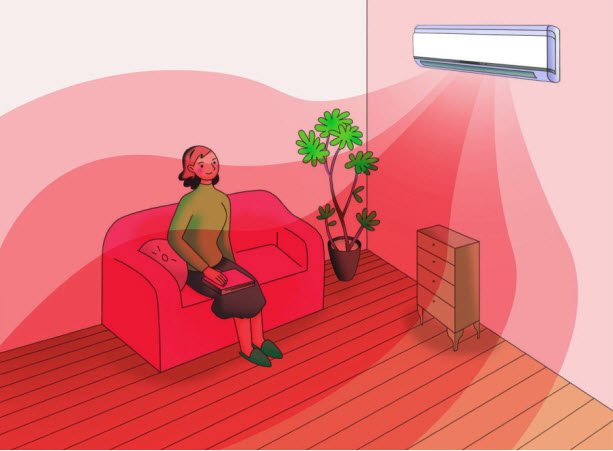
Analysis of the data shows that it will be beneficial to use an air conditioner as a heating device for a country house if gas is not supplied to the dwelling, and you have to choose between diesel fuel, coal, liquefied gas or electricity as a heat source.... Also, heating a room with an air conditioning system can be considered by owners of houses without a stove.
It should be noted that it is more profitable to use split systems for heating in regions with mild winters, since models that can operate at low temperatures are more expensive and require special maintenance. If frosty weather prevails, or the network gas is supplied to the house, then heating the home through the air conditioning system will have few advantages.
On a note! Heating with air conditioning is advisable, for example, in the off-season, when it is already cool outside, but the utilities have not yet turned on the central heating.
Can the air conditioner work for heating


From time to time, the air conditioner turns on the defrosting mode, as ice forms on it.
Many people have a question about whether it is possible to use an air conditioner in winter for heating? We unambiguously state that split systems work both for cooling and heating the air. It is worth noting that not all air conditioners are equipped with a heating function, and the temperature regime for different models may differ.
Doubts about whether the air conditioner can work for heating arise due to frequent reviews that the split system does not heat the air. Sometimes this happens due to technical necessity, for example, when the system thaws, but there are also unforeseen cases. Why the air conditioner does not work for heating, reasons:
- poor quality unit;
- inconsistency of weather conditions with the declared characteristics;
- untimely service;
- compressor failure or freon leakage.
Whether it is possible to turn on the air conditioner for heating in winter depends on the weather conditions.If your device is designed for up to -5 degrees, then you should not turn it on at a lower temperature, although, most likely, the split system will not start in severe frost.
At a price, floor insulation with expanded clay in a wooden house will be the cheapest.
Read about insulating a brick wall with expanded clay here.
The principle of operation for heating
The main operating principle of the air conditioner, whether it be heating or cooling, remains unchanged and is based on a change in the state of aggregation of the refrigerant, which, like all substances, absorbs heat during evaporation and releases it during condensation. The used refrigerant circulates between the indoor and outdoor units and transports the heat either outdoors or indoors.


Freon is used as a refrigerant, which can equally easily be heated and cooled due to evaporation, condensation, expansion and contraction. Therefore, a decrease in temperature is achieved as a result of the conversion of freon into a gaseous state, and an increase, on the contrary, into a liquid form. The compressor is responsible for the compression of freon, and its expansion occurs in the capillary tube. Changing modes from cooling to heating becomes possible by changing the movement of freon, which is achieved by installing a 4-way valve that changes the direction of flow.
When the air conditioner turns on the heating mode, the following occurs:
- in the external unit, the compressor compresses freon, which heats up from this and then flows through the tubes to the internal unit.
- being in the inner part, the heated refrigerant gives off heat to the air in the room through a heat exchanger and cools down;
- the freon that has given off the heat enters the street unit again and, evaporating, gives off the residual cold to the street air through the heat exchanger - this happens even if there is frost outside the window;
- then the process is repeated: freon enters the compressor, where it is compressed and heated.
Can the air conditioner be turned on in winter (heating)?
Turn on the air conditioner for heating in winter, if it has such a mode, of course, you can. But you need to consider the temperature limits and the capabilities of your model. In order for the air conditioner to function normally at low temperatures even in winter, it is necessary to equip the external unit with the so-called "winter kit", which is based on the RDK device and heaters. The winter kit prevents the formation of ice on the external unit and inside it, helps to remove moisture from the evaporator unit.
Having installed the winter kit on the air conditioner, you can use it in heating mode even at -20 ° C outside the window.


Temperature limits
There is an important limitation for all air conditioners: the minimum temperature at which it can operate. This is due to the fact that for the normal functioning of the compressor, oil is needed, which begins to thicken at low temperatures, which is fraught with damage to the device at startup.
Important! At low temperatures outside, freon may not have time to evaporate, then it will enter the indoor unit in liquid form, and this can provoke a water hammer.


The minimum temperature that allows the air conditioner to function normally is -80C for most models. Some split systems have a lower allowable value: up to -150C. However, even in these models, the performance of devices at sub-zero temperatures deteriorates by 70% of the data indicated in the technical data sheet.
On a note! To compensate for negative weather factors, many experts recommend using a special winter kit, which consists of an oil heater for the compressor and radiators that are resistant to condensation and icing.
Efficiency and thermal efficiency
The power consumption when heating the air conditioner is related to the net power, allowing you to calculate the efficiency - the efficiency of the system. Net power is the amount of heat transferred per unit of time. If the efficiency of the air conditioner in heating mode is more than 1, we can talk about its efficient operation. As a rule, the amount of heat generated by a household split-system is 3-4 times higher than the energy consumption for its production (this indicator depends on the temperature outside). Low consumption and high heat output make the air conditioner not only comfortable, but also an economical solution in the fight against off-season cold.
Special development of TM Fujitsu engineers
Inverter air conditioner with heating function and TM Fujitsu NORDIC winter kit is perhaps the best air conditioner for heating. This is the most advanced equipment to date for creating warmth and comfort in the house with a minimum of cost. The Airflow Nordic and Deluxe Slide Nordic models with an inverter compressor and an enlarged heat exchanger differ from the on / off segment in their lower energy consumption, increased heat production capacity and an advantageous energy efficiency ratio.
Which is more efficient - NORDIC or electric heater?
NORDIC air conditioners were originally developed for consumers in Canada and Scandinavia, where cold climates prevail. NORDIC models have been tested not only in laboratories, but also in real northern winter conditions. Even at a temperature of -25 ℃, the NORDIC split system has an energy efficiency coefficient for heating COP = 2.147. This means that in real operating conditions, the air conditioner produces more than 2 kW of thermal energy, while consuming only 1 kW from the network.
In turn, any electric heater cannot produce more thermal energy than it consumes electric, since it only converts one type of energy into another. Its COP does not exceed 1. Thus, even in the harsh winter conditions, heated air conditioners of the Fujitsu brand are more than 2 times more efficient than the most modern electric heaters.
NORDIC technologies:
- Two-cylinder rotary compressor with increased performance;
- The compressor compartment is enlarged to protect the compressor;
- A powerful heater for the drain pan, located under the heat exchanger and the fan, reliably protects them from freezing;
- The outdoor unit components have undergone rigorous cold resistance testing and certified by the Canadian Standards Association (CSA).
Note that only split systems based on inverter technologies are presented in the current line of household air conditioning TM Fujitsu, and their energy efficiency class varies from A to A +++.
Fujitsu air conditioners using i-PAM (Intelligent Power Module and Pulse Amplitude Modulation) technology make even more energy efficient use. This ensures a much faster achievement of the required microclimate parameters. The set temperature in heating mode is reached almost 3 times faster than in the standard inverter model.
Separately, it is worth mentioning the function "Maintain + 10 ℃ in heating mode" - a mode in which the air conditioner automatically maintains the room temperature at + 10 ℃ in order to avoid chilling out the house in winter.
Varieties of air conditioners for heating
Since the main weaknesses of split systems operating for heating are loss of performance and an increased risk of breakdown at low temperatures, manufacturers are constantly working on improving the design of devices, as well as developing new types of refrigerants. There are several types of these air conditioners, each with their own pros and cons.
Split systems with heat pumps
Split systems with a heat pump are complex engineering designs designed to increase the efficiency of heating the room even when operating in frosty conditions. Such a device has the following design features:
- increased size of the heat exchanger;
- installation of a more efficient fan in the outdoor unit, which improves the efficiency of heat transfer;
- heating the compressor crankcase, as well as the outdoor unit, which, when operating at low temperatures, prevents the formation of ice;
- more accurate regulation of the refrigerant supply to the heat exchanger depending on weather conditions, which is carried out using an electronic control valve.


On a note! Many models of equipment with a heat pump use special types of freon that are effective at low temperatures.
Air source heat pump with boiler
This is one of the types of split systems that are designed for heating or cooling, as well as for supplying hot water. In addition, an air source heat pump with a boiler can become part of the underfloor heating system. Unlike most models operating on the air-to-air principle, this type of device uses the air-water principle in operation.... Such a device is perfect for a private house located in an ecologically clean area, since it does not emit combustion products into the air.


Constant performance systems
For large premises, for example, shopping or office centers, not separate air conditioners are used, but semi-industrial systems of constant performance. They are complex engineering structures of several types.
- Cassette split systems are not built into the wall, but into the suspended ceiling and, thanks to their design, distribute the air flow in 4 directions at the same time. This ensures uniform heating of a large pavilion.


- Floor-to-ceiling air conditioners help to create an optimal microclimate in rooms where it is difficult to place wall-mounted or cassette devices, since they can be installed on the floor close to the wall or on the ceiling of the building. The fastening is secured by a special mounting plate.

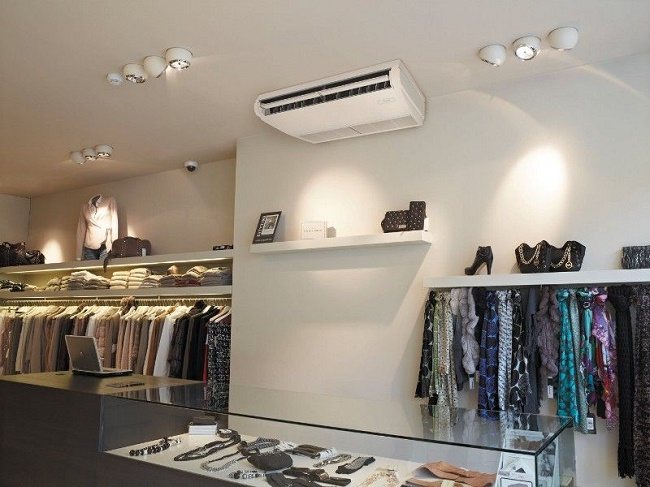
- Duct models are another type of semi-industrial systems, the peculiarity of which is that the external unit is not mounted on the wall of the building, but mounted inside the air duct system. For this reason, duct systems are preferred when the street unit must be hidden from prying eyes.


- Column air conditioners are installed on the floor in offices, cafes and other establishments where architectural features or design exclude the possibility of installing climate control equipment on the ceiling or wall. The device itself is made in the form of a column, does not take up much space and directs the air flow to the ceiling.


Inverter systems
Conventional air conditioners with heating mode, when the room reaches the required temperature, turn off the compressor and put it into standby mode until the values decrease. This leads to quite large temperature fluctuations. In addition, constant switching on and off of the device increases the wear of its parts.
Inverter models are distinguished by the ability to regulate the speed of the compressor motor, therefore maintaining the set value is achieved by changing the performance of the device. This leads to small fluctuations in the room temperature and saves electricity as much less electricity is consumed at low engine speeds.... Therefore, many buyers prefer inverter models.


Arctic execution
Split systems of arctic performance are called devices that have been specially designed to operate at low temperatures. For example, there are models that cope with the task of heating even at -300C.
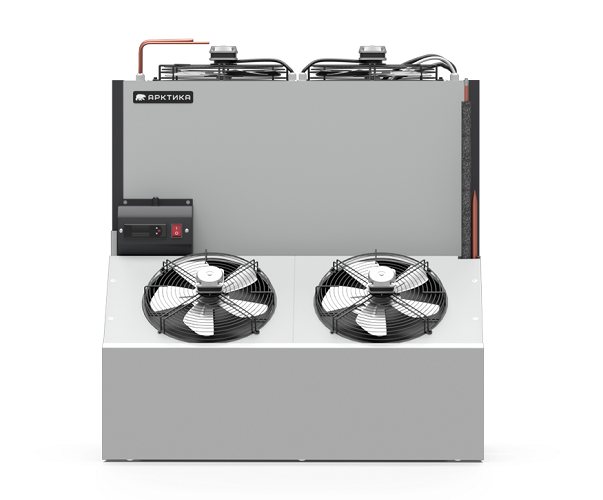

Monoblocks
To simplify the design and installation of complex air conditioning systems, as well as to minimize the use of freon lines, it is often practiced to install compact heat pumps for local heating.
On a note! Such devices are quite cheap. The only requirement is that the outside of the air conditioner is outdoors. Therefore, monoblocks are built into a wall or window.


Rooftops
Rooftops are air conditioners for cooling and heating, the units of which are located on the roof, as a rule, on opposite sides of the roof covering at a minimum distance. Such an installation helps to distribute heat as evenly as possible over the entire area of the house. In addition, rooftops do not need additional air supply to cool the surface of the outdoor unit.


Air conditioner operation in winter in heating mode
outdoor unit heat exchanger
Speaking about the principle of operation of the air conditioner for heat, one can involuntarily think about how the heating process takes place in autumn-winter temperatures outside. Is it possible to warm up with this appliance at all?
The bulk of split systems cannot be switched on in frosts below -5 ° C, for inverter systems these indicators reach -10 °. It is because of the decrease in efficiency, which in normal conditions reaches almost 300%, that the operation of the air conditioner in winter for heat becomes unprofitable. The temperature difference between the outdoor air and the heat exchanger of the outdoor unit must be at least 4-5 ° C. In cold weather, this principle is violated, and heat extraction becomes problematic.
Another reason why an ordinary air conditioner cannot be turned on for heat in winter is the occurrence of technical problems in the system due to:
- undersizing of the capacitor of the outdoor unit;
- thickening of oil in the compressor crankcase;
- freezing of condensate in the drain hose;
- flowing into the crankcase of freon in a liquid state during a cold start.
It turns out that the operation of the air conditioner in the winter time for heat brings more problems than benefits. An exception may be split systems of some Japanese brands, which equip their refrigeration machines with built-in heaters for the drain hose and crankcase, and also use the technology of two-phase freon injection and compressors with an injection nozzle. Such units also heat at -25 ° C.
There are winter kits for split systems, consisting of a drain heater, a fan retarder and a compressor crankcase heater. Many are mistaken, believing that with them you can turn on the air conditioner in winter to heat even at -20 ° C.
A split system equipped with a low-temperature kit may only be used for cooling in frost!
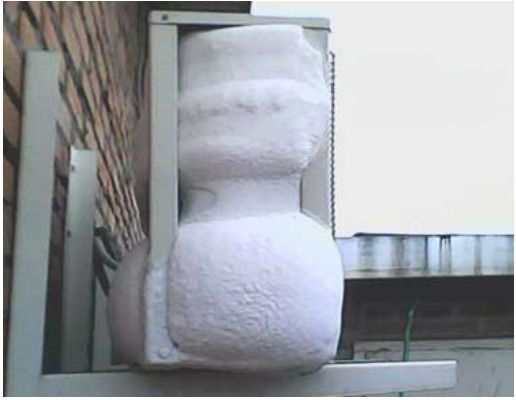

the effects of air conditioning in winter
When buying, you should definitely pay attention to the restrictions on the operation of the air conditioner for heat / cold, since not all models are able to maintain the required temperature parameters in a particular region. The standard limitation of the heating temperature at the lower limit of the norm is down to -5 ° C.
What other operational features of the air conditioner exist when working on heat? It should be borne in mind that the upper limit of the norm also exists. Most of the domestic class on / off split systems are set to heat the room from + 18-20 ° C. If it is necessary to expand these boundaries, a model is selected that is designed for the northern regions and countries.
Criteria for choosing heated air conditioners
Modern air conditioners are multifunctional devices. To choose the best option, you should consider the following criteria:
- the minimum allowable outdoor air temperature for work;
- maximum thermal power;
- energy efficiency COP;
- noise level;
- performance, which must correspond to the heated area;
- installation cost;
- the presence of filters to clean the air from dust particles, allergens, bacteria, as well as from unpleasant odors;
- the presence of a built-in on and off timer, which allows you to heat up the air in the apartment at a certain moment;
- the presence of an auto-defrosting system designed to minimize the risk of icing of the external module;
- the presence of the restart function, which will help to automatically restore work in the event of a power outage;
- the presence of a "winter kit", which will be required when operating equipment in cold weather;
- proven manufacturer.
The advantages and disadvantages of such heating
Air conditioners and split systems, providing for the possibility of heating a room, have their own advantages and disadvantages. After careful analysis of real user reviews, the main aspects were highlighted in the following table.
| pros | Minuses |
| High efficiency. | High price of split systems with heating mode. |
| Rapid air heating. | A complex device. |
| Low energy consumption compared to heaters, since electricity is not spent on heat generation, but only on heat transfer. | The need to use a winter kit. |
| More even distribution of heat in the room compared to stationary heaters. | To avoid lubrication downtime, the air conditioner will have to be turned on periodically. |
| Since air conditioners do not have a heating element (such as heating elements), they practically do not burn air in the room and do not emit carbon monoxide. | When installing equipment operating on the principle of heat pumps, careful and complex design is necessary, otherwise separate cold zones may appear in the room, and condensation will settle on the glass. |


How to turn on the air conditioner for heating on the remote control?
To turn on the heating function on the air conditioner using the control panel, regardless of the model, you need to perform a few simple steps:


- Take the remote control from your air conditioner and turn on the device as usual, i.e. press the ON / OFF button.
- The remote control must have a "MODE" button. Press it and switch modes until the "sun" icon or the inscription "HEAT" is displayed on the screen.
- Press the "HEAT" key (or the "sun" icon). This will enable the split-system to be switched to heating mode and heat the room up to 30 ° C.
- If your remote control does not have a "MODE" button, look at the buttons with the "snowflake", "fan", "droplet", "sun" icons. Click "sun". If there is neither "sun" or "HEAT" on the remote control, but other modes are displayed, then your air conditioner does not support the heating function.
- Pay attention to the buttons marked "+" and "-". They allow you to adjust the temperature from 1 ° C and above. Using them, set comfortable conditions for yourself (the set temperature should be higher than the one that currently exists in the room). Or use the up and down keys.
- Make sure to wait about 5-10 minutes. Warm air will not flow right away. First, the fan will turn on, then the air begins to heat up. But pay attention, the device should react to your actions (beep, blink, turn on / off).
You can, on the contrary, first set the heating on the remote control and only then turn on the air conditioner (press the "ON" button). For some models, this is the correct order.
Recommendations for use
To extend the life of the air conditioner and achieve high productivity of its work, the following rules must be observed:
- change filters periodically;
- regularly top up the refrigerant, as its volume decreases over time - on average, this should be done every 3 years;
- observe the recommended operating temperature of the device as accurately as possible;
- in winter, cover the outdoor unit with a waterproof material.
So, in order to find out the whole truth about the advantages of using an air conditioner that runs on heating, it will be useful to look for information about various models, study the reviews and personal experience of the owners in specialized forums. The forumhouse, which is dedicated to country life and construction, has many articles on this topic, as well as cost calculations and user advice.





